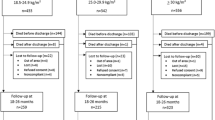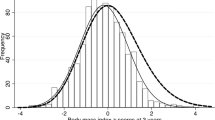Abstract
Objective:
Thirty-five percent of women of child-bearing age are obese, and there is evidence that maternal obesity may increase the risk for adverse neurodevelopmental outcome. However, research regarding obesity and neurodevelopment among children born preterm is limited. This study aimed to determine associations between maternal obesity and neurodevelopment in very preterm children at age 2 years.
Study Design:
Maternal/infant dyads (n=62) born ⩽30 weeks gestation were enrolled in a prospective cohort study at a level-III neonatal intensive care unit. Mothers were classified as obese or non-obese based on pre-pregnancy body mass index. Infants underwent magnetic resonance imaging at term equivalent and developmental testing at age 2. Maternal obesity was investigated for associations with neurodevelopment.
Result:
Maternal obesity was associated with positive screen for autism (odds ratio=9.88, P=0.002) and lower composite language scores (β=−9.36, (confidence interval=−15.11, −3.61), P=0.002).
Conclusion:
Maternal obesity was associated with adverse neurodevelopmental outcome at age 2 in this cohort of very preterm children. This study requires replication, but may support targeted surveillance of infants born to women with maternal obesity.
This is a preview of subscription content, access via your institution
Access options
Subscribe to this journal
Receive 12 print issues and online access
$259.00 per year
only $21.58 per issue
Buy this article
- Purchase on Springer Link
- Instant access to full article PDF
Prices may be subject to local taxes which are calculated during checkout
Similar content being viewed by others
References
Jeffery RW, Utter J. The changing environment and population obesity in the United States. Obesity Res 2012; 11 (S10): 12S–22S.
Nodine PM, Hastings-Tolsma M. Maternal obesity: improving pregnancy outcomes. MCN: Am J Matern Child Nurs 2012; 37 (2): 110.
Flegal KM, Carroll MD, Kit BK, Ogden CL. Prevalence of obesity and trends in the distribution of body mass index among US adults, 1999-2010. JAMA 2012; 307 (5): 491–497.
Catalano P. The impact of gestational diabetes and maternal obesity on the mother and her offspring. J Dev Orig Health Dis 2010; 1 (04): 208–215.
Trasande L, Lee M, Yinghua L, Weitzman M, Savitz D. Incremental charges, costs, and length of stay associated with obesity as a secondary diagnosis among pregnant women. Med care 2009; 47 (10): 1046–1052.
Van Lieshout R, Taylor V, Boyle M. Pre‐pregnancy and pregnancy obesity and neurodevelopmental outcomes in offspring: a systematic review. Obes Rev 2011; 12 (5): e548–e559.
Basatemur E, Gardiner J, Williams C, Melhuish EC, Barnes J, Sutcliffe A. Relationship between maternal body mass index and child cognition: evidence from the UK Millennium Cohort Study. Paediatrics 2013; 131 (1): 56–63.
Hinkle SN, Sharma AJ, Schieve LA, Ramakrishnan U, Swan DW, Stein AD. Reliability of gestational weight gain reported postpartum: a comparison to the birth certificate. Matern Child Health J 2012; 17 (4): 756–765.
Krakowiak P, Walker CK, Bremer AA, Baker AS, Ozonoff S, Hansen RL et al. Maternal metabolic conditions and risk for autism and other neurodevelopmental disorders. Pediatrics 2012; 129 (5): e1121–e1128.
Tozuka Y, Wada E, Wada K. Diet-induced obesity in female mice leads to peroxidized lipid accumulations and impairment of hippocampal neurogenesis during the early life of their offspring. FASEB J 2009; 23 (6): 1920–1934.
Bilbo SD, Tsang V. Enduring consequences of maternal obesity for brain inflammation and behavior of offspring. FASEB J 2010; 24 (6): 2104–2115.
Helderman JB, O’Shea TM, Kuban KCK, Allred EN, Hecht JL, Dammann O et al. Antenatal antecedents of cognitive impairment at 24 months in extremely low gestational age newborns. Pediatrics 2012; 129 (3): 494–502.
Hertz-Picciotto I, Delwiche L. The rise in autism and the role of age at diagnosis. Epidemiology 2009; 20 (1): 84–90.
Cockburn F, Cooke R. The crib (clinical risk index for babies) score: a tool for assessing initial neonatal risk. Lancet 1993; 342 (8865) 193–198.
Anderson P, Doyle LW. Neurobehavioral outcomes of school-age children born extremely low birth weight or very preterm in the 1990 s. JAMA 2003; 289 (24): 3264–3272.
Cheong JL, Hunt RW, Anderson PJ, Howard K, Thompson DK, Wang HX et al. Head growth in preterm infants: correlation with magnetic resonance imaging and neurodevelopmental outcome. Pediatrics 2008; 121 (6): e1534–e1540.
Hamrick SE, Hansmann G. Patent ductus arteriosus of the preterm infant. Pediatrics 2010; 125 (5): 1020–1030.
Hintz SR, Kendrick DE, Vohr BR, Poole WK, Higgins RD. Gender differences in neurodevelopmental outcomes among extremely preterm, extremely‐low‐birthweight infants. Acta Paediatr 2007; 95 (10): 1239–1248.
Hintz SR, Kendrick DE, Wilson-Costello DE, Das A, Bell EF, Vohr BR et al. Early-childhood neurodevelopmental outcomes are not improving for infants born at< 25 weeks' gestational age. Pediatrics 2011; 127 (1): 62–70.
Klinger G, Levy I, Sirota L, Boyko V, Lerner-Geva L, Reichman B. Outcome of early-onset sepsis in a national cohort of very low birth weight infants. Pediatrics 2010; 125 (4): e736–e740.
Leversen KT, Sommerfelt K, Rønnestad A, Kaaresen PI, Farstad T, Skranes J et al. Prediction of neurodevelopmental and sensory outcome at 5 years in Norwegian children born extremely preterm. Pediatrics 2011; 127 (3): e630–e638.
Patole S, Deshpande G. Effect of Necrotizing Enterocolitis on Growth and Development in Preterm Neonates. Handbook of Growth and Growth Monitoring in Health and Disease: Springer, Elsevier, 2012, p 567–583.
Pietz J, Peter J, Graf R, Rauterberg-Ruland I, Rupp A, Sontheimer D et al. Physical growth and neurodevelopmental outcome of nonhandicapped low-risk children born preterm. Early Hum Dev 2004; 79 (2): 131–143.
Reagan PB, Salsberry PJ. Race and ethnic differences in determinants of preterm birth in the USA: broadening the social context. Soc Sci Med 2005; 60 (10): 2217–2228.
Stoll BJ, Hansen NI, Bell EF, Shankaran S, Laptook AR, Walsh MC et al. Neonatal outcomes of extremely preterm infants from the NICHD Neonatal Research Network. Pediatrics 2010; 126 (3): 443–456.
Kidokoro H, Neil J, Inder T. A new MRI assessment tool to define brain abnormalities in very preterm infants at term. Am J Neuroradiol 34 (11): 2208–2214.
Nguyen The Tich S, Anderson PJ, Shimony JS, Hunt RW, Doyle LW, Inder TE . A novel quantitative simple brain metric using MR imaging for preterm infants. AJNR Am J Neuroradiol 2009; 30 (1): 125–131.
Klein A, Ghosh SS, Avants B, Yeo BT, Fischl B, Ardekani B et al. Evaluation of volume-based and surface-based brain image registration methods. NeuroImage 2010; 51 (1): 214–220.
Avants BB, Tustison NJ, Wu J, Cook PA, Gee JC. An open source multivariate framework for n-tissue segmentation with evaluation on public data. Neuroinformatics 2011; 9 (4): 381–400.
Avants BB, Tustison NJ, Song G, Cook PA, Klein A, Gee JC. A reproducible evaluation of ANTs similarity metric performance in brain image registration. NeuroImage 2011; 54 (3): 2033–2044.
Hill J, Dierker D, Neil J, Inder T, Knutsen A, Harwell J et al. A surface-based analysis of hemispheric asymmetries and folding of cerebral cortex in term-born human infants. J Neuroscience 2010; 30 (6): 2268–2276.
Hill J, Dierker D, Neil J, Inder T, Knutsen A, Harwell J et al. A surface-based analysis of hemispheric asymmetries and folding of cerebral cortex in term-born human infants. J Neurosci 2010; 30 (6): 2268–2276.
Robins DL, Fein D, Barton ML, Green JA. The Modified checklist for autism in toddlers: an initial study investigating the early detection of autism and pervasive developmental disorders. J Autism Dev Disord 2001; 31 (2): 131–144.
Snow AV, Lecavalier L . Sensitivity and specificity of the Modified Checklist for Autism in Toddlers and the Social Communication Questionnaire in preschoolers suspected of having pervasive developmental disorders. Autism 2008; 12 (6): 627–644.
Carter A, Briggs-Gowan M . Infant Toddler Social and Emotional Assessment (ITSEA) . San Antonio, TX: Psychological Corporation, Harcourt Assessment, 2006.
Bayley N. Bayley Scales of Infant and Toddler Development® 3rd Edition (Bayley-III®) 1969.
Moore T, Johnson S, Haider S, Hennessy E, Marlow N. Relationship between test scores using the second and third editions of the Bayley Scales in extremely preterm children. J Pediatr 2012; 160 (4): 553–558.
Spittle AJ, Anderson PJ, Lee KJ, Ferretti C, Eeles A, Orton J et al. Preventive care at home for very preterm infants improves infant and caregiver outcomes at 2 years. Pediatrics 2010; 126 (1): e171–e178.
O’Brien TE, Ray JG, Chan W-S. Maternal body mass index and the risk of preeclampsia: a systematic overview. Epidemiology 2003; 14 (3): 368–374.
Neggers YH, Goldenberg RL, Ramey SL, Cliver SP. Maternal prepregnancy body mass index and psychomotor development in children. Acta Obstet Gynecol Scand 2003; 82 (3): 235–240.
Leavey A, Zwaigenbaum L, Heavner K, Burstyn I. Gestational age at birth and risk of autism spectrum disorders in alberta, Canada. J Pediatr 2012; 162 (2): 361–368.
Laptook AR, O'Shea TM, Shankaran S, Bhaskar B. Adverse neurodevelopmental outcomes among extremely low birth weight infants with a normal head ultrasound: prevalence and antecedents. Pediatrics 2005; 115 (3): 673–680.
Tanda R, Salsberry PJ, Reagan PB, Fang MZ. The impact of prepregnancy obesity on children’s cognitive test scores. Matern Child Health J 2012; 1–8.
Anderson PJ, De Luca CR, Hutchinson E, Roberts G, Doyle LW. Underestimation of developmental delay by the new Bayley-III Scale. Arch Pediatr Adolesc Med 2010; 164 (4): 352.
Moore T, Johnson S, Haider S, Hennessy E, Marlow N. Relationship between test scores using the second and third editions of the Bayley scales in extremely preterm children. J Pediatr 2011; 160 (4): 553–558.
Norman JE, Reynolds R. Symposium I: consequences of obesity and overweight during pregnancy the consequences of obesity and excess weight gain in pregnancy. Proc Nutr Soc 2011; 70 (4): 450–456.
Moore T, Johnson S, Hennessy E, Marlow N. Screening for autism in extremely preterm infants: problems in interpretation. Dev Med Child Neurol 2012; 54 (6): 514–520.
Ming X, Brimacombe M, Wagner GC. Prevalence of motor impairment in autism spectrum disorders. Brain Dev 2007; 29 (9): 565–570.
Rapin I, Dunn M. Update on the language disorders of individuals on the autistic spectrum. Brain Dev 2003; 25 (3): 166–172.
Acknowledgements
We wish to acknowledge Karen Lukas RN (Washington University School of Medicine), Anthony Barton (Washington University School of Medicine), Jessica Conners (Washington University School of Medicine), Dimitrios Alexopolous MS (Washington University School of Medicine), Joe Ackerman, Jr (Washington University School of Medicine), Claudine Vavasseur MD (National Maternity Hospital, Dublin Ireland) and Han Tjoeng MD (University of Hawaii) who obtained informed consents and conducted patient-oriented responsibilities to support the success of this project. We also wish to thank all the families whose infants participated in this study. This project was supported by the National Institute of Health (ROI HD 057098), the Doris Duke Foundation, the Washington University Intellectual and Developmental Disabilities Research Center (NIH/NICHD P30 HD062171), and the UL1 TR000448, sub award KL2 TR000450 from the National Center for Advancing Translational Sciences.
Author information
Authors and Affiliations
Corresponding author
Ethics declarations
Competing interests
The authors declare no conflicts of interest.
Rights and permissions
About this article
Cite this article
Reynolds, L., Inder, T., Neil, J. et al. Maternal obesity and increased risk for autism and developmental delay among very preterm infants. J Perinatol 34, 688–692 (2014). https://doi.org/10.1038/jp.2014.80
Received:
Revised:
Accepted:
Published:
Issue Date:
DOI: https://doi.org/10.1038/jp.2014.80
This article is cited by
-
Prenatal Programming of Monocyte Chemotactic Protein-1 Signaling in Autism Susceptibility
Molecular Neurobiology (2024)
-
The association of maternal overweight on long-term neurodevelopmental outcomes in premature infants (< 29 weeks) at 18–24 months corrected age
Journal of Perinatology (2023)
-
High-Fat Diet Exacerbates Autistic-Like Restricted Repetitive Behaviors and Social Abnormalities in CC2D1A Conditional Knockout Mice
Molecular Neurobiology (2023)
-
Language function following preterm birth: prediction using machine learning
Pediatric Research (2022)
-
The impact of maternal obesity on childhood neurodevelopment
Journal of Perinatology (2021)



